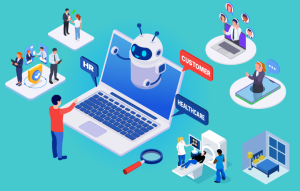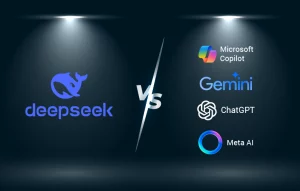Imagine a customer service experience that feels less like a robotic script and more like a friendly conversation with a helpful representative. Enter the world of conversational AI, where chatbots shed their limitations and evolve into intelligent assistants capable of understanding your needs, responding naturally, and even offering a touch of empathy.
This isn’t a fantasy; it’s the reality unlocked by conversational AI, and business leaders, take note! This transformative technology isn’t just about improving customer experience; it holds the key to optimizing costs, streamlining operations, and gaining valuable data-driven insights. Join us as we explore how conversational AI services empower business leaders to navigate the evolving customer service landscape and unlock significant business value.
“According to Statista, the global market revenue generated by the chatbot industry is $137.6 million this year. Over the next few years, the chatbot industry is expected to witness more growth and is predicted to reach a market revenue of $454.8 million by 2027.”
How conversational AI transformed user interactions
Remember those frustrating encounters with early AI chatbots? Imagine typing a simple question like “What are your store hours?” only to be met with a robotic “I don’t understand your query.”
It wasn’t uncommon for these rudimentary tools to misinterpret even basic phrases, leaving users feeling more confused than informed. These rule-based chatbots, while offering an initial foray into human-computer interaction, were limited by their rigid scripting and inability to grasp the nuances of human language.
So, how did we get here? The key lies in the power of natural language understanding (NLU). This technology allows AI chatbots to analyze the structure, meaning, and intent behind your words, not just the literal string of characters. It’s like giving the chatbot a brain that can decipher the “why” behind your query, enabling it to respond thoughtfully and accurately.
This shift toward conversational AI chatbots unlocks a range of benefits for both users and businesses. For users, the experience is no longer one of frustration but rather of convenience and efficiency. Imagine seamlessly resolving an issue with a virtual assistant, scheduling appointments effortlessly, or even receiving personalized product recommendations – all through a natural, conversational flow.
The role of rule-based chatbots in the era of conversational AI
While conversational AI chatbots dominate the spotlight today, it’s crucial to acknowledge the trailblazers that paved the way – rule-based chatbots. These early pioneers, though limited in their capabilities, laid the foundation for the sophisticated interactions we now enjoy.
Think of a rule-based chatbot as a diligent student following a meticulously crafted script. Equipped with predefined keywords and responses, they could offer basic functionalities like answering FAQs or providing simple instructions. Imagine asking “What are your return policies?” and receiving a clear, pre-written explanation. While helpful, the conversation lacked the flexibility and adaptability to handle unexpected inquiries or deviate from the script.
As technology advanced, the need for more natural and engaging interactions became apparent. This is where conversational AI stepped in, bringing a paradigm shift from scripted responses to dynamic, personalized dialogues.
Conversational chatbots: Beyond scripted interactions, embracing natural conversations
So, what sets conversational chatbots apart? The key lies in their ability to process and interpret human language with remarkable accuracy. Powered by NLU, they can grasp the nuances of your words, including intent, sentiment, and even context. This allows them to respond thoughtfully, dynamically adapting to the flow of the conversation. Picture asking about product recommendations, and the chatbot doesn’t just list generic options; it delves deeper, inquiring about your preferences, budget, and usage needs before suggesting tailored recommendations.
The benefits of conversational chatbots extend far beyond basic functionality. For users, they offer:
- Natural interactions: Imagine no more struggling to phrase your questions just right; chatbots understand your intent, making communication as seamless as talking to a friend.
- Personalized experiences: No more generic responses; chatbots adapt to your needs and preferences, offering relevant information and support.
- 24/7 availability: Need help at 3 AM? Conversational chatbots are always there, providing information and resolving issues around the clock.
- Improved customer satisfaction: By offering personalized support and resolving issues quickly, chatbots increase customer satisfaction, leading to higher retention and loyalty.
- Reduced support costs: Chatbots can handle routine inquiries and basic troubleshooting, freeing up human agents for complex issues, optimizing resource allocation.
- Enhanced operational efficiency: Automating repetitive tasks like data gathering and appointment scheduling, chatbots streamline operations and boost overall efficiency.
For businesses, the advantages are equally compelling:
Conversational AI and chatbots – what’s the difference?
| Feature | Conversational AI | Chatbot |
| Definition | The underlying technology and algorithms that empower chatbots to understand and respond to human language in a natural and engaging way. | The visible interface, the communication channel through which users interact with the underlying technology. |
| Key Technologies | (NLU), machine learning, dialogue management | Predefined responses, keywords, basic scripting |
| Capabilities | Dynamic and personalized responses, adapts to user intent, learns and improves over time | Limited responses based on specific inputs, no learning or adaptation |
| Benefits | More natural and engaging user experiences | Basic functionality, cost-effective for simple tasks |
| Analogy | The cognitive ability of a salesperson, understanding your questions and adapting responses | A vending machine, offering limited options based on specific button presses |
| Use Cases | Customer service, education, healthcare, entertainment | Simple tasks like answering FAQs, providing basic instructions |
| Future Potential | Transforming human-computer interaction and seamless experiences | Evolving to incorporate more AI capabilities |
| Customization & Flexibility | Highly customizable and adaptable to specific needs | Limited customization, relies on rigid scripts |
| Scalability & Growth | Continuously learns and improves, scales seamlessly | Limited scalability, requires manual updates |
| Overall Value | Strategic investment for long-term growth and innovation | Cost-effective option for basic tasks |









